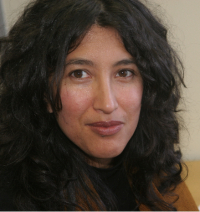Posted on March 14, 2010

Dear Minister Xingwana
To place yourself before a work of art is a complex and potentially transformative experience. Sometimes that means looking at something you'd rather not see. But as the Minister of Arts and Culture, you preside over a realm in which that line between what you'd rather not see and what you need to look at is an ever-present factor, and a theme of much art.
Minister, I invite you to look at art that challenges you, like that of Nandipha Mntambo and Zanele Muholi. That looking is an active and complicated experience that includes all the discomfort, shock, unsettling of established notions, new ideas and feelings that you appear to have had at the Innovative Women exhibition, and that together can amount to illumination. That is what art does. The problem with walking out of an exhibition is that you miss the many meanings that the works evoke, both separately and together. You miss what they create and unsettle, and therefore the possibility of transformation.
Immoral, offensive and going against nation-building - there were children as young as three years old in the room - where do we draw the line between art and pornography.
Minister, where does this language come from?
When you turn to such justifications for your actions, it is our duty as artists, writers, feminists and citizens to point out how revealingly close your words are to those of the apartheid censors.
Artists and governments have always had a contentious relationship. Artists can reach into the minds of people and change them. That is a power that states are wary of and want to regulate. But to constrict art is to erase the capacity for imagining what does not yet exist. We need that capacity because our world is imperfect and we need visionary, epiphanic initiatives if we are to succeed in changing it. Art generates epiphanies.
So let us name what happened in that brief glance, that instantaneous assessment, that abrupt walking out, and the explanations from your office that followed. Let us name it and its dangers.
The name is censorship, and the dangers are reactionary ideas about art and the fueling of homophobia.
Fortunately, there is another language for thinking about art and artists. Minister, what would you have seen if you had stayed and viewed the works of Nandipha Mntambo and Zanele Muholi alongside all the other artists in the Innovative Women exhibition and talked about them with other visitors?
You would have seen works that use the language of allusion, intimacy, beauty and pleasure.
During your brief glance, you may have mistaken the intimacy in Muholi's images for pornography and the erudite allusions in Mntambo's work for carelessness about sexual violence, but that mistake can only be sustained if you don't truly look at their art. If you stood in front of Muholi's photographs, you would see lesbian lives outside of the narratives of violation and pornography through which they are more commonly presented to us. You would see how her work opens up a discussion about visibility itself. For lesbians, visibility carries an immense cost - the feminist writer Pumla Gqola calls this a “hyper-visibilityâ€Â that has been used to violate lesbian lives through a sensationalistic focus on suffering that has simultaneously made it possible to ignore that suffering. Muholi's images confront such hyper-visibility and reclaim a space for the women in her photographs away from denigration and hostility and toward presence, pleasure and wholeness. Her work shows us there is no category of human being whom it is safe to despise and whose hurt it is expedient to ignore.
And once the photos existed and came into public view, other good followed. Some of the best new South African writing on art, citizenship and belonging has been sparked by Muholi's work, including essays by Desiree Lewis, Pumla Gqola and Gabi Ngcobo. You might be pleased to know, Minister, that this new direction has also been traced by a vanguard of the African continent's finest feminist scholars, among them Sylvia Tamale, Patricia McFadden and Charmaine Pereira.
No artist is afraid of being a dissident to conventional thinking. That is their role. Mntambo, Muholi and other artists continuously spark our creative, ethical and political responses, but also our personal and affective ones. We envisage ourselves anew after their art enters our imaginations. If we see someone's wholeness, can we continue to ignore their violation? The most radical possibility of art is to generate change – and in the process create a more inclusive notion of community.
Minister, perhaps unintentionally, your words have generated a great deal of alarm in the world of the arts and among those of us who strongly support the rights of gays and lesbians. We wonder if we are entering “our George Bush years,â€Â as Gender Commissioner Yvette Abrahams contemplated on hearing your comments, ironically at a conference on the contemporary meanings of Sara Baartman, where Abrahams and Muholi argued for the revolutionary possibilities of love and art for directly addressing racism and its violent legacies.
Minister, I would like to imagine a different outcome to this controversy. I want to imagine you will come back to the images you walked away from, and look deeply at what you thought you didn't want to see. I imagine you rethinking received ideas about art and pornography (the great poet and activist Audre Lorde gives us some beautifully nuanced insights on this) and arriving at a hard-earned transformation. I think of you reflecting on your responsibilities as the guardian of the nation's best impulses in art and culture – which is not to limit but to enable such work. Then perhaps this experience of looking again at the thing you didn't want to see will have brought you closer to the most radical and expansive possibilities of art.
Gabeba Baderoon
Gabeba Baderoon is a poet and scholar. Details of her work are at www.gabeba.com